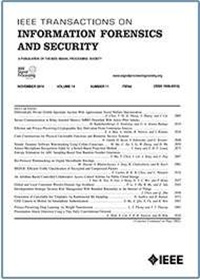密码指令集扩展原型的信息泄漏评估
IF 8
1区 计算机科学
Q1 COMPUTER SCIENCE, THEORY & METHODS
IEEE Transactions on Information Forensics and Security
Pub Date : 2025-01-17
DOI:10.1109/TIFS.2025.3531239
引用次数: 0
摘要
基于软件的加密实现提供了灵活性,但它们面临性能限制。相反,基于硬件的加密加速器利用特定于应用程序的定制来提供实时安全解决方案。密码学指令集扩展(CISE)结合了基于硬件和基于软件的解决方案的优点,提供了更高的性能和原子级密码学操作的灵活性。虽然CISE被广泛用于开发安全解决方案,但基于CISE的设备的侧信道分析还处于起步阶段。具体来说,重要的是评估基于cises的设备的电力使用和电磁发射是否与其内部操作有任何关联,攻击者可以利用这些操作来推断加密秘密。在本文中,我们提出了一个测试向量泄漏评估框架,用于在设计生命周期的早期阶段评估预硅原型。具体来说,我们首先确定具有通过功率侧信道签名泄露信息的可能性的功能单元,然后通过生成必要的固件来最大化侧信道签名,从而在系统原型上对它们进行评估。我们在两个基于RISC-V的密码扩展RISCV-CRYPTO和XCRYPTO上的实验结果表明,即使在全系统模式下,8个与AES和sha相关的原型功能单元中有7个容易通过其功率侧信道签名泄露密码秘密,其统计显著性为$\alpha = 0.05$。本文章由计算机程序翻译,如有差异,请以英文原文为准。
CiseLeaks: Information Leakage Assessment of Cryptographic Instruction Set Extension Prototypes
Software based cryptographic implementations provide flexibility but they face performance limitations. In contrast, hardware based cryptographic accelerators utilize application-specific customization to provide real-time security solutions. Cryptographic instruction-set extensions (CISE) combine the advantages of both hardware and software based solutions to provide higher performance combined with the flexibility of atomic-level cryptographic operations. While CISE is widely used to develop security solutions, side-channel analysis of CISE-based devices is in its infancy. Specifically, it is important to evaluate whether the power usage and electromagnetic emissions of CISE-based devices have any correlation with its internal operations, which an adversary can exploit to deduce cryptographic secrets. In this paper, we propose a test vector leakage assessment framework to evaluate the pre-silicon prototypes at the early stages of the design life-cycle. Specifically, we first identify functional units with the potential for leaking information through power side-channel signatures and then evaluate them on system prototypes by generating the necessary firmware to maximize the side-channel signature. Our experimental results on two RISC-V based cryptographic extensions, RISCV-CRYPTO and XCRYPTO, demonstrated that seven out of eight prototype AES- and SHA-related functional units are vulnerable to leaking cryptographic secrets through their power side-channel signature even in full system mode with a statistical significance of $\alpha = 0.05$ .
求助全文
通过发布文献求助,成功后即可免费获取论文全文。
去求助
来源期刊

IEEE Transactions on Information Forensics and Security
工程技术-工程:电子与电气
CiteScore
14.40
自引率
7.40%
发文量
234
审稿时长
6.5 months
期刊介绍:
The IEEE Transactions on Information Forensics and Security covers the sciences, technologies, and applications relating to information forensics, information security, biometrics, surveillance and systems applications that incorporate these features
 求助内容:
求助内容: 应助结果提醒方式:
应助结果提醒方式:


